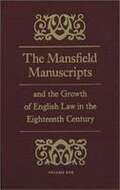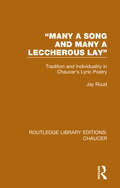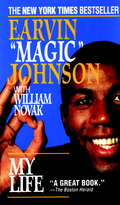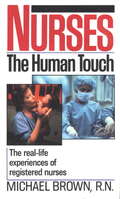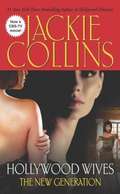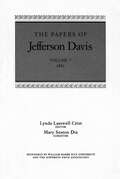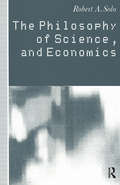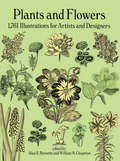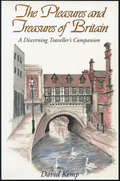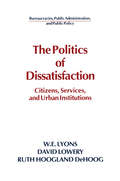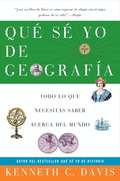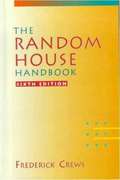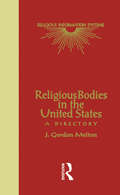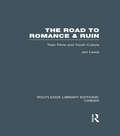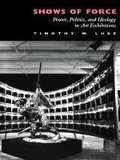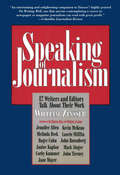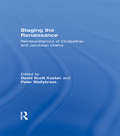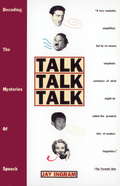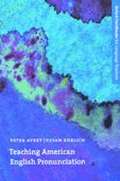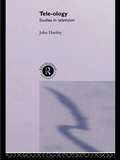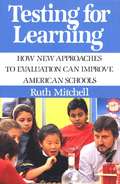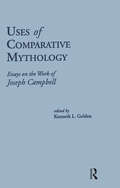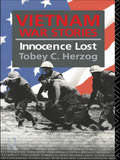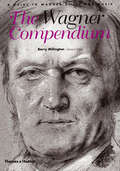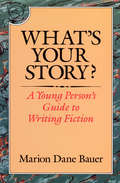- Table View
- List View
The Mansfield Manuscripts and the Growth of English Law in the Eighteenth Century (Studies in Legal History #Vol. 1)
by James OldhamUsing voluminous trial notes and previously unexplored documents, Oldham provides a reappraisal of the judicial career of Lord Mansfield, chief justice of the Court of King's Bench in England from 1756 to 1799. <p><p> In this two-volume work, he presents important biographical information about Mansfield and brings to life the context, personalities, and operational features of the Court of King's Bench during the eighteenth century.
"Many a Song and Many a Leccherous Lay": Tradition and Individuality in Chaucer's Lyric Poetry (Routledge Library Editions: Chaucer)
by Jay RuudOriginally published in 1992. Although they were apparently much appreciated in his own time, Chaucer’s lyrics have for most of the modern era been the most neglected of his poetic productions. This work offers a comprehensive overview of Chaucer’s lyric corpus. The author extends his scope to include in-depth discussions of literary and cultural influences that have their impact on Chaucer’s lyrics. Students who come to Chaucer’s poems for the first time will here receive an excellent introduction to each poem, the important literary issues surrounding the poem as defined by previous scholarship, and Ruud’s own clear style and balanced judgment. The persuasive proofs for Chaucer’s lyric innovations and his special style of poetry will also be of interest to Chaucerian specialist academics. The book traces Chaucer’s development as a lyric poet, from more conventional early works to more individualized later ones.
My Life
by Earvin Magic Johnson"A true emotional phenomenon...Entertaining...Of particular interest to fans will be the evolution of Johnson's relationship with Bird, his great karmic partner in the game."NEW YORK NEWSDAYHe's faced challenges all of his life, but now Magic Johnson faces the biggest challenge of all, his own brave battle with HIV. In this dramatic, exciting, and inspirational autobiography, Magic Johnson allows readers into his life, into his tirumphs and tragedies on and off the court. In his own exuberant style, he tells readers of the friends and family who've been constant supporters and the basketball greats he's worked with. It's all here, the glory and the pain the character, charisma, and courage of the hero called Magic.AN ALTERNATE SELECTION OF THE BOOK-OF-THE-MONTH CLUBFrom the Paperback edition.
Nurses
by Michael BrownRegistered nurse Michael Brown has interviewed over fifty practicing nurses, spanning forty-one states and most nursing specialties. He takes you to the front lines of his profession, where split-second, life-and-death decisions are made every day by these unsung heroes of health care, who put their own lives at risk to provide support and comfort to those who need it most..From the Paperback edition.
Old Wives Tales: The Truth Behind Common Notions
by Sue CastleFrom the book Jacket: Will a little warm milk really help you sleep? Should you put butter on a burn? Does turning a light off for a few minutes use more energy than it saves? Will chicken soup cure your cold? If you pick a baby up every time she cries, will she get spoiled? Here is the book that will set the record straight on the received wisdom and commonly accepted notions we've routinely followed for generations. The result of years of research, accumulated facts and a healthy dose of suspicion, Old Wives' Tales will entertain as it informs, offering not only the real basis in fact but also the origin and purpose of Mom's or her friends' sometimes dubious counsel, along with comments from a wide variety of experts, bona fide and otherwise. Understanding that today's up-to-the-minute advice may be tomorrow's old wives' tale, Sue Castle challenges this new wisdom with some penetrating questions and astute observations that will lead you to take at least some of the health gurus with a grain of salt. If you're still holding your breath trying to cure the hiccups or putting sugar on a cut and wondering why, here is a reference book you can't afford to be without.
The Papers of Jefferson Davis: 1861 (The Papers of Jefferson Davis #7)
by Jefferson DavisLynda Lasswell Crist, EditorMary Seaton Dix, CoeditorIntroduction by Frank E. VandiverVolume 7 of The Papers of Jefferson Davis offers a unique view of 1861, the first year of the Confederacy, Davis' presidency, and the Civil War.On January 21 Davis made his affecting farewell speech before a hushed Senate, then left for Mississippi. His uncertainty over a military or political course vanished when he received news of his unanimous election as president of the Confederate States of America. Inaugurated at Montgomery, Alabama, on February 18, Davis quickly set to work to forge a government, in a race with events to select a cabinet, establish departments, and plan for the common defense.Hopes for a peaceful separation from the North ended with the firing on Fort Sumter; subsequent documents reveal a president absorbed by the problems of waging a war that soon stretched from the Atlantic Coast to the Gulf of Mexico. Victory at Manassas produced euphoria among southerners but plunged the president into the first of several unfortunate controversies with his generals, this one over the failure to pursue the enemy and capitalize on success.Throughout 1861 the Confederate commissioners in Europe reported to Davis on their expectations of recognition, convinced that the demand for cotton would induce Great Britain and France to break the North's blockade of southern ports and help supply arms for the defense of the fledgling nation.Volume 7 provides a rare opportunity to assess anew Davis' strengths and weaknesses as executive, to reexamine his relationship with generals, governors, congressmen, cabinet officers, the press, and the public. Davis ended the year as he begun, aware of the difficulties of the course the South had adopted and confident that its cause would ultimately triumph. Containing illustrations, maps, and more than 2,500 documents drawn from numerous printed sources and more than seventy repositories and private collections, Volume 7 covers a year of paramount importance in our country's history.
The Philosophy of Science and Economics
by Robert A. SoloThe philosophy of science proposes criteria to delineate true science and a theory to explain its progress. As a graduate student under the supervision of Lionel Robbins and Karl Popper, Solo first challenged the viability of those criteria and that theory in relation to economics and the social sciences. Here he explains how the foundations of that philosophy have been eroded through the advent of quantum mechanics and through Kuhn's "Structures of Scientific Revolution", and demonstrates its irrelevance to a social science that would comprehend social reality and contribute to the formation of social policy. He proposes a different mode of perception, and different rules for determining the acceptability of statement, a different language of discourse, and a different structure of organization than presently prevails.
Plants and Flowers: 1761 Illustrations for Artists and Designers (Dover Pictorial Archive Ser.)
by Alan E. Bessette William K. ChapmanThis comprehensive archive offers authentically detailed, copyright-free illustrations of hundreds of plants and flowers from around the world. Ideal for graphic artists, designers, and others in the arts and crafts, it will also serve both serious and casual botanists as a convenient reference and key to identification of a broad range of botanical species. Each illustration has been carefully selected from botanical archives for its scientific accuracy, artistic style, and suitability for reproduction. The plants and flowers are grouped by kind, uses, and habitats into seventeen categories, among them aquatic plants, carnivorous plants, grasses, rushes and sedges, orchids, ornamental plants, plants of commerce, mushrooms, molds and lichens, ferns, mosses, trees, shrubs, weeds, wildflowers, and vines. For easy and accurate reference, both common and botanical Latin names are given for each species whenever possible. All names have been compiled into two convenient indexes. Alan E. Bessette, Professor of Biology at Utica College of Syracuse University, is a well-known naturalist, botanical photographer, and author of numerous books and field guides on botanical subjects. William K. Chapman, a biology teacher and member of the adjunct faculty at Utica College, is a well-known speaker and writer on the gathering of wild foods, and the author of field guides to plants and animals of the Adirondacks.
The Pleasures and Treasures of Britain
by David KempIs a famous queen of Britain really bured beneath platform 10 at King’s Cross station in London? What is the telephone number of the National Theatre? what is the best place to eat in Worcester? Where is the National Bagpipe Museum? (Hint: not in Scotland) Was Pointius Pilate born in Pitlochry? The answers to these questions and literally thousands more are to be found in David Kemp’s fascinating guidebook, The Pleasures and Treasures of Britain. Nowhere else will the discerning traveller find so much diverse and essential information about British culture gathered together in one volume. With the author as your witty and knowledgeable guide, take a tour through nearly fifty cities, from Penzance to Perth, from London to Cardiff and Belfast. Each city section begins with a concise, readable history and a guided walk around the town, planned to take in as many of the significant local sights as can comfortably be included. Next are exhaustive listings, including telephone numbers and addresses, of everything a culturally curious visitor might want to seek out: theatre, art galleries, museums, antique markets, antiquarian and other bookstores, restaurants, lcoal fairs and festivals and more. Finally, under the headings of Artistic Associations and Ephemera, each section concludes with an entertaining collection of local lore, gossip, legend and anecdote.
The Politics of Dissatisfaction: Citizens, Services and Urban Institutions (Bureaucracies, Public Administration, And Public Policy Ser.)
by William E. Lyons David Lowery Ruth Hoogland DeHoogThe Politics of Dissatisfaction: Citizens, Services, and Urban Institutions is destined to be a classic in public administration and public policy; it makes major theoretical and empirical contributions to the literature in both fields. It is a rigorous empirical attempt to assess the public choice view of citizenship and local government. The research upon which this book is based was founded on conversations between two of its authors, W. E. Lyons and David Lowery, during the early 1980s.
Que Se Yo de Geografia
by Kenneth C. DavisAcompáñanos mientras Kenneth C. Davis, autor del bestseller Qué Sé Yo de Historia, nos lleva en un fascinante, asombroso y divertidísimo tour del planeta Tierra -- una excursión que nos abrirá los ojos y la imaginación a un extenso, salvaje y sorprendente mundo que no conocíamos.
The Random House Handbook (Sixth Edition)
by Frederick CrewsThe Random House Handbook, Sixth Edition offers a comprehensive guide to writing and style, as well as special applications.
Religious Bodies in the U.S.: A Dictionary (Religious Information Systems)
by J. Gordon MeltonFirst Published in 1992. Routledge is an imprint of Taylor & Francis, an informa company.
The Road to Romance and Ruin: Teen Films and Youth Culture (Routledge Library Editions: Cinema)
by Jon LewisThis book analyses the teen film as the rare medium able to represent the otherwise chaotic and conflicting experience of youth. The author focuses on six major issues: alienation, deviance and delinquency, sex and gender, the politics of consumption, the apolitics of youth(ful) rebellion, and regression into nostalgia. Despite the many differences within the genre, this book sees all teen films as focused on a single social concern: the breakdown of traditional forms of authority – school, church, family. Working with the theories of such diverse scholars as Kenneth Keniston, Bruno Bettelheim, Erik Erikson, Theodor Adorno, Simon Frith, and Dick Hebdige, the author draws an innovative and flexible model of a cultural history of youth. Originally published in 1992.
Shows of Force: Power, Politics, and Ideology in Art Exhibitions
by Timothy W. LukeIt has long been considered a mark of naïveté to ask of a work of art: What does it say? But as Timothy W. Luke demonstrates in Shows of Force, artwork is capable of saying plenty, and much of the message resides in the way it is exhibited. By critically examining the exhibition of art in contemporary American museums, Luke identifies how art showings are elaborate works of theater that reveal underlying political, social, and economic agendas.The first section, "Envisioning a Past, Imagining the West," looks at art exhibitions devoted to artworks about or from the American West. Luke shows how these exhibitions--displaying nineteenth- and early-twentieth century works by artists such as George Caleb Bingham, Frederic Remington, Frederic Edwin Church, and Georgia O'Keefe--express contemporary political agendas in the way the portray "the past" and shape new visions of "the West."In "Developing the Present, Defining a World," Luke considers artists from the post-1945 era, including Ilya Kabokov, Hans Haacke, Sue Coe, Roger Brown, and Robert Longo. Recent art exhibits, his analysis reveals, attempt to develop politically charged conceptions of the present, which in turn struggle to define the changing contemporary world and art's various roles within it.Luke brings to light the contradictions encoded in the exhibition of art and, in doing so, illuminates the political realities and cultural ideologies of the present. Shows of Force offers a timely and surely controversial contribution to current discussions of the politics of exhibiting art.
Speaking of Journalism
by William ZinsserVeteran journalist and writing teacher William Zinsser, whose books on writing have sold more than 700,000 copies, presents 11 of his most successful students discussing what it is like to work as a journalist in the 1990s.
Staging The Renaissance: Reinterpretations Of Elizabethan And Jacobean Drama
by David Scott Kastan Peter StallybrassFirst published in 1992. Routledge is an imprint of Taylor & Francis, an informa company.
Talk Talk Talk: Decoding the Mysteries of Speech
by Jay IngramWith a mixture of erudition and humor, Canadian radio personality Jay Ingram discusses the sociology of talking: the dynamics of conversation, men and women's different propensities for interrupting, and even the proper use of "you know." But he also delves into the mystery-riddled physiology of talking. While we now know that certain areas of the brain seem to control specific aspects of speech--from articulating words to creating meaningful sentences--how do scientists explain the extraordinary case of the young stroke victim who lost only the words for fruits and vegetables? Is it possible that the ability to talk is actually encoded in our genes, as some scientists believe?From the language roots of North America to the speech differences between Neanderthals and Cro-Magnons, from modern children creating whole new languages in one generation to Freudian slips, from talking to yourself to speaking in tongues, Talk, Talk, Talk covers the gamut of humankind's most enigmatic and intriguing skill. Impeccably researched, lively and accessible, Talk, Talk, Talk is a book you won't be able to keep quiet about.
Teaching American English Pronunciation
by Peter Avery Susan EhrlichUnlike books aimed at linguistics students or individual learners of English, Teaching American English Pronunciation specifically addresses the needs of ESL teachers. It provides the descriptive knowledge needed to teach pronunciation effectively. But it is also full of practical teaching ideas. The book is divided into three main parts: - Part One is an introduction to the English sound system. It covers spelling and pronunciation, the individual sounds of English, English sounds in context, the shape of English words, word stress and vowel reduction, and connected speech. Throughout this part of the book, the authors use examples of typical errors made by ESL students to illustrate the descriptions and concepts they describe. - Part Two describes the pronunciation problems that most ESL students have with English vowels, consonants, stress, rhythm, and intonation. It then goes on to look at the specific pronunciation problems of speakers of fifteen different languages: Arabic, Chinese, Farsi, French, German, Greek, Hindi and Punjabi, Italian, Japanese, Korean, Polish, Portuguese, Spanish, and Vietnamese. - Part Three consists of a set of articles about practical issues in pronunciation teaching. These are written by ten North American teachers and language researchers with a wide range of experience of teaching in many different contexts. The topics covered include: pronunciation syllabus design, pronunciation-based listening activities, developing self-correcting and self-monitoring strategies, and drama techniques in the pronunciation class.
Tele-ology: Studies in Television
by John HartleyTeleology brings together John Hartley's work on television. The book draws on current critical theory in cultural studies to develop a wide-ranging and thought-provoking view of television broadcasting in Britain, Australia and the USA.Neighbours, Hancock's Half Hour, Dallas, Monty Python, Miami Vice, Beverly Hillbillies and Bonanza are among the examples of TV art that are discussed in Hartley's exploration of cultural politics. He takes in TV truth and propaganda; populism in the news; mythologies of the audience; TV drama as a `photopoetic' genre in the tradition of Shakespeare; Kylie Minogue, Madonna and gardening shows.
Testing for Learning
by Ruth MitchellArguing that traditional, test-based evaluation has a negative effect on many students, this book describes new methods of assessing student performance.
Uses of Comparative Mythology: Essays on the Work of Joseph Campbell (Routledge Library Editions: Myth Ser. #3)
by Kenneth L. GoldenThis collection, first published in 1992, offers critical-interpretive essays on various aspects of the work of Joseph Campbell (1904-1987), one of a very few international experts on myth. Joseph Campbell examines myths and mythologies from a comparative point of view, and he stresses those similarities among myths the world over as they suggest an existing, transcendent unity of all humankind. His interpretations foster an openness, even a generous appreciation of, all myths; and he attempts to generate a broad, sympathetic understanding of the role of these 'stories' in human history, in our present-day lives, and in the possibilities of our future.
Vietnam War Stories: Innocence Lost
by Tobey C. HerzogThe Gulf War and its aftermath have testified once again to the significance placed on the meanings and images of Vietnam by US media and culture. Almost two decades after the end of hostilities, the Vietnam War remains a dominant moral, political and military touchstone in American cultural consciousness. Vietnam War Stories provides a comprehensi
The Wagner Compendium: A Guide To Wagner's Life and Music
by Barry MillingtonThe unrivaled single-volume survey of Wagner's life and work Edited by one of the leading Wagner scholars of modern times, and with contributions from seventeen experts from around the world, The Wagner Compendium is the key to a complete understanding of the composer-- the most comprehensive, informative and well-organized guide to his life and times. Features include: calendar of Wagner's life, works and related events who's who of Wagner's contemporaries details of historical, intellectual and musical background exploration of Wagner's character and opinions full list of Wagner's prose writings comprehensive listing and discussion of the works
What's Your Story?: A Young Person's Guide to Writing Fiction
by Marion Dane BauerThe award-winning author &“provides mentoring and practical and technical advice in this handy how-to book . . . as useful to teachers as to young writers&” (School Library Journal, starred review). Storytelling is a universal experience. From an early age, we begin to shape our own world by crafting tales. But learning to tell—and write—a good story isn&’t easy. It takes dedication and practice, just like for a musician or an athlete, and it can be just as rewarding to accomplish as winning a game or mastering an instrument. It&’s the kind of work that feeds our souls and makes us glad to be alive. In What&’s Your Story?, Newbery Medal-winning author Marion Dane Bauer discusses how to write fiction from beginning to end, including creating a story plan, choosing the best idea, bringing characters to life, deciding on a point of view, creating realistic dialogue, keeping readers hooked, and revising and polishing the finished product. &“Her last comment is telling: &‘Knowing your craft can help you tell a story. But only by taking risks can you make art.&’ After many pages of provocative information and straightforward counsel, that sentence may be the one to launch youngsters to the challenge. The book speaks directly to young writers, but many adults (teachers, librarians, reviewers, editors, would-be writers) will also find this sensible dissection of the storytelling process invaluable.&”—Kirkus Reviews (starred review) &“A pragmatic, organized approach to story writing . . . the exercises and thought processes introduced as groundwork come across as stimulating rather than tedious and may serve to hone analytical skills as well as inspire even the most reluctant writers to try their hand.&”—Publishers Weekly
